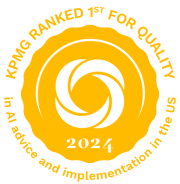Reimagining strategic workforce planning in government
Why AI calls for more holistic and innovative talent decision-making

AI-powered digital workers, including AI agents, are rapidly becoming a reality, disrupting traditional workforce planning methods. As these AI agents integrate into operations, organizations must adapt their workforce planning to accommodate both human and digital workers, ensuring seamless interaction and collaboration. Agencies are re-evaluating the "how" and "who" of work, transitioning from merely filling roles to focusing on securing essential skills, regardless of whether they are provided by humans or digital entities. This shift carries significant implications for human resource leaders and their stakeholders.
Quite simply, organizations can no longer rely on traditional workforce planning methods. A more effective approach is strategic workforce planning, which focuses on determining the most critical tasks, the skills needed to achieve organizational goals, and the most suitable sources—human or digital—to fulfill those needs. And as digital workers become more prevalent, some organizations are adopting an even broader approach that is influenced by broader market data and trends: total workforce planning.
What is Strategic Workforce Planning?

Strategic workforce planning is an organizational process designed to align an organization’s workforce capabilities with strategic objectives and operational needs. The approach requires collaboration across finance, human resources, and operations to systematically identify, recruit, develop, and deploy human and digital talent resources to optimize performance and achieve long-term sustainability. Through strategic workforce planning, organizations can access the right capabilities, in the right locations, at the right times, and for the right cost.
Many organizations report that strategic workforce planning initiatives generate cost savings of an average of 10 percent of their annual labor budget through minimized attrition, optimized staffing, and improved resource allocation.i
Strategic workforce planning enables organizations to look beyond job descriptions and fill talent gaps based on skills rather than the specific roles employees held previously. Requisite skills should be viewed through the lens of drivers (e.g., new products and expanded locations), while talent management leaders assess whether they have requisite skills in the human workforce or whether they need to acquire them through external recruitment, upskilling, or augmentation with digital tools such as AI agents.
AI-Driven Workforce Planning: Real-World Examples
- Healthcare: AI agents can help organizations manage staff certifications and make real-time staffing decisions based on evolving patient needs. Automating processes and decisions such as these reduces the burden on human managers while elevating patient care delivery and clinical outcomes.
- Project management: AI can supercharge project management across sectors with more sophisticated mechanisms for forecasting skill requirements and reallocating resources as projects begin and end. These dynamic, nuanced insights prevent costly talent loss and help maximize the use of available skills for higher project efficiency and less downtime.
Build, Buy, Borrow, or Bot Skills?
Following these analyses, an organization can determine how to obtain the skills it needs. Typically, there will be several options—namely, buy, build, borrow, or bot. In other words, should you hire new talent? Develop current talent? Engage more part-timers or freelancers? Or, increasingly, leverage digital labor either on its own or in conjunction with human labor?
Each option offers its own benefits:
allows the organization to hire external talent for skills that may be difficult or time consuming to develop, while also gaining fresh perspectives.
through training and upskilling fosters opportunities for employee career growth, reinforcing organizational loyalty and enhancing engagement.
such as contractors, allows rapid scaling of the workforce up or down as needed and offers access to specialized skills for short-term needs.
to work both autonomously and in collaboration with human employees on both short-term tasks and complex long-term projects.
The Case for Total Workforce Planning
Traditionally, organizations employing strategic workforce planning have relied primarily on internal data to forecast staffing needs. In light of a tight labor market for certain roles and in certain geographies and sectors, economic and policy fluctuations, and evolving work models that now include digital workers, many organizations are shifting toward a more holistic approach known as Total Workforce Planning.
With the rise of digital workers, many organizations are shifting to this more comprehensive approach that incorporates both internal data and external market insights to help forecast and fulfill skills-based staffing requirements.
In total workforce planning, supply inputs change based on outside-in market data that helps provide insights into expected changes in supply and demand. For example, if external data indicates insufficient talent availability, organizations can use AI agents or look in different locations to fill supply gaps. This shift integrates technology, process, and strategy into one cohesive approach.
AI agents play a role in total workforce planning by analyzing if/then scenarios and presenting human resources and talent management with options and recommendations. Outcomes could include redesigning jobs by offloading certain tasks to AI agents. Or taking a process with numerous steps and pushing some of the tasks to an AI agent, with or without a “human in the loop.” Still another involves using external data to reveal broader industry trends affecting talent availability, tenure, and demand for critical skills. In short, total workforce planning takes traditional HR capabilities and layers on technology to help elevate workforce planning strategies and processes.
Key Factors in Strategic Staffing Decisions
Making talent decisions depends on several factors:
1
Budget
Identify areas where AI agents can take over tasks or automated workflows to reduce operational costs. To cover the remaining work, assess whether hiring people with requisite skills or training/upskilling current employees is more cost-effective.
2
Timing
Training and upskilling take time. Consider whether there is time to train existing staff or if the skills are needed quickly. An organization that is already understaffed will likely opt to invest in new hires and supplement with contract and/or digital labor. On the other hand, if the organization has a propensity for long tenure and investment in current employees makes sense, it will likely opt for internal training.
3
The labor market
In high-demand, low-supply industries, organizations might choose contract workers or AI agents to fill gaps, avoiding overtime costs and burnout. The alternative would be to risk overburdening full-time staff, resulting in overtime costs, burnout, and potential turnover. By employing strategic workforce planning, organizations can gain timely insight into workforce requirements and gaps to proactively secure the right coverage at the right time to meet evolving needs.
The Role of AI in Workforce Planning

Organizations are conducting total workforce planning at a critical juncture: AI is both disrupting how work is done and unleashing powerful new ways of optimizing workforce planning processes.
For example, as they deploy AI agents, organizations will need technological staff with advanced AI skills, as well as nontechnical employees who know how to use and collaborate with AI. Of course, as AI agents automating transactional tasks may make some skills obsolete, leading to a mismatch between workers' skills and organizational needs. What do you do with these employees—retain them despite the cost? Reskill them in other areas more valuable to the organization? Or hire AI-savvy talent instead?
As organizations move toward total workforce planning, they can use AI to make sense of these staffing issues, including predicting future skill requirements, aligning supply and demand, and balancing human and digital labor.
Implementing an Effective Workforce Planning Strategy
Organizations looking to implement total workforce planning should consider three imperatives:
1
Match technology to maturity:
Simply selecting AI agents won’t solve your workforce needs. Before implementing a solution, ensure you have in place a clean job architecture, robust data, a skills-based ecosystem, and the appropriate workforce strategy to enable a future-ready workforce.
2
Anticipate organizational changes driven by AI:
AI has the potential to drive growth and enable groundbreaking creativity and productivity by helping employees create innovative products, personalize customer experiences, automate content creation, among other capabilities. At the same time, rapid organizational changes driven by AI means it will be critical for workforce planning to be conducted in collaboration with finance and operations. Finance needs to keep an eye on whether workforce changes enabled by AI support the organization’s growth objectives. Leaders play a role in assessing talent supply against projected demand, using operational plans and financial forecasts to ensure the right capabilities are available at the right time. And HR departments need to adopt a growth mindset as AI plays a larger role in real-time workforce planning.
3
Leadership alignment and education:
Workforce planning should be a continuous process influenced by many variables that require organization-wide buy-in and collaboration. For these strategies to be truly impactful, leaders need to cascade organizational goals and strategic objectives into these processes, ensuring workforce decisions align with their vision.
Embracing AI Agents for a Smarter Workforce
Total workforce planning is essential in today's rapidly changing environment, with AI as both a driver and a critical tool in the process. Traditional headcount planning is no longer sufficient, as organizations must now focus on evolving tasks and skills while digital labor takes on more of the work. To maximize the value of workforce planning, organizations should align with stakeholders from finance, HR, and operations—and secure leadership buy-in—so workforce decisions support strategic objectives, operational needs, and growth imperatives.
Why KPMG is Your Strategic Workforce Planning Partner
KPMG helps organizations implement advanced workforce planning strategies by leveraging our proprietary workforce insights model and agentic-AI tools. Our customized AI agents draw on a wide range of datasets to provide valuable insights for organizations. Working with KPMG helps ensure that organizations can effectively conduct talent opportunity and deployment assessments, securing the right mix of digital and human skills to help meet strategic needs.
As organizations continue their AI journey, KPMG offers a human-centered solution to help address workforce challenges and futureproof your operations. Our tailored approach helps ensure your workforce, operating model, and technological maturity are precisely aligned. From identifying AI-enablement opportunities to integrating digital workers and reshaping roles, we help you achieve sustainable success.
Begin Your Journey Towards Maximizing AI-Driven Workforce Innovation with KPMG
As organizations continue their AI journeys, KPMG LLP (KPMG) offers a human-centered solution to help address workforce challenges and futureproof operations. Our tailored approach helps ensure your workforce, operating model, and technological maturity are precisely aligned. From identifying AI-enablement opportunities to integrating digital workers and reshaping roles, we help you achieve sustainable success.e.
Our proprietary workforce insights model and agentic-AI tools enable organizations to implement advanced workforce planning strategies effectively. Customized AI agents harness robust datasets to provide actionable intelligence, helping organizations conduct talent opportunity and deployment assessments and securing the right mix of digital and human skills to meet their strategic needs.
Unlock AI Workforce Opportunities
Identify and capitalize on AI opportunities across the entire workforce, including human and digital labor. We help ensure your organization maximizes efficiency and productivity by maximizing the impact of AI.
Redesign Jobs and Roles with AI
Take a human-centered approach to redesigning jobs, roles, and occupations to help maximize the impact of AI. Our experts help reimagine your workforce structure so that human and digital workers can effectively capitalize on each other's strengths for optimal performance.
Drive AI Engagement and Adoption
Activate change at all organizational levels, building awareness, understanding, and commitment to incorporating AI into daily work processes. We help create a culture that embraces AI, enhancing collaboration between human employees and AI agents.
Enhance AI Learning and Development
Deliver role-specific AI and Generative AI learning programs, continuously updated to equip your workforce with the latest skills and knowledge. Our tailored training helps ensure your employees stay ahead of the curve in a rapidly evolving digital landscape.

KPMG ranks #1 for quality AI advice and implementation in the US
According to senior buyers of consulting services who participated in the Source study, Perceptions of Consulting in the US in 2024, KPMG ranked No. 1 for quality in AI advice and implementation services.
Insights to help you elevate your workforce operations
What sets apart good from great workforce leaders? It's their ability to harness innovative technology to drive efficiency and foster growth.

Optimizing your government workforce
A guide to enhancing efficiency, effectiveness, and employee experience in federal and state governments

Rebuild your workforce to make the most of your agency
Embrace agile workforce models, refine roles, prioritize coaching, and focus on upskilling to boost innovation

5 benefits of skills-based talent strategies in government
Future-proof your workforce with a skills-based talent strategy

GenAI is transforming work and the government workforce
Discover how KPMG can help shift from technology-centric to human-experience focus in the GenAI era

Transform your government workforce to excel with GenAI
Enhance your future workforce by combining cutting-edge technology with human innovation
Want to receive the latest government insights?
Opt-in today and be the first to receive the latest industry updates from KPMG
Meet our team


